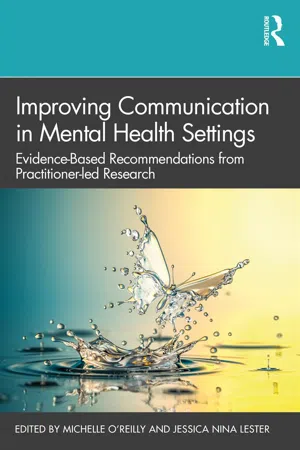
Improving Communication in Mental Health Settings
Evidence-Based Recommendations from Practitioner-led Research
- 280 pages
- English
- ePUB (mobile friendly)
- Available on iOS & Android
Improving Communication in Mental Health Settings
Evidence-Based Recommendations from Practitioner-led Research
About This Book
Improving Communication in Mental Health Settings draws on empirical studies of real-world settings to demonstrate contemporary practice-based evidence, providing effective strategies for communicating with patients/clients in mental health settings.
The book integrates clinical experience and language-based evidence drawn from qualitative research. Drawing on studies that utilize scientific language-based approaches such as discourse and conversation analysis, it focuses on social interaction between professionals and patients/clients to demonstrate effective communication practices. Chapters are led by clinical professionals and feature a range of mental health settings, different mental health conditions and types of patient/client, and evidence-based recommendations.
This book is an essential guide for professionals working in mental health and/or social work, and those training or working in clinical areas of mental health practice.
Frequently asked questions
Information
Chapter 1
Communication, mental health, and how language-based research can help in practice
Introduction
Communication and mental health
Aims and objectives
Discourse and conversation analysis
Discourse analysis
Conversation analysis
Relevance of discourse and conversation analysis to mental health
Table of contents
- Cover
- Half Title
- Title Page
- Copyright Page
- Contents
- Acknowledgements
- Editor Biographies
- List of Contributors
- 1 Communication, mental health, and how language-based research can help in practice
- PART I: Communication with children and families
- PART II: Communication with adults
- PART III: Learning Journeys: From theory to practice
- Index